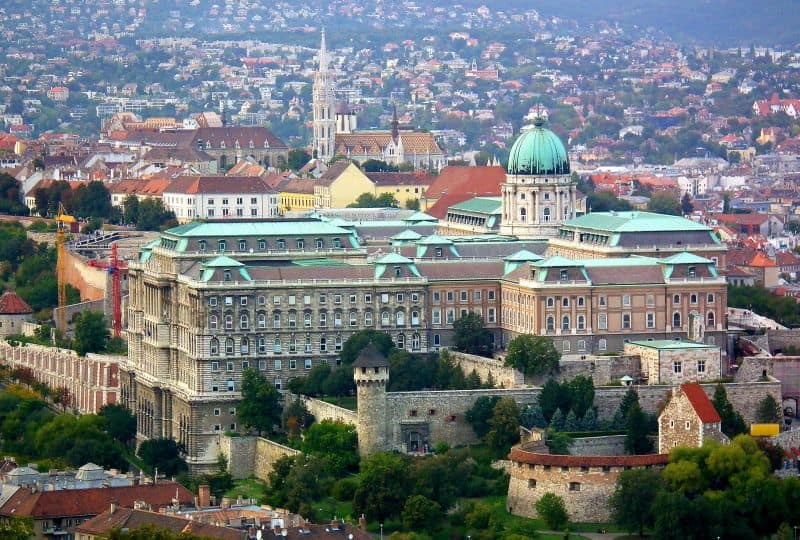Castle District
For a romantic walk surrounded by history, the Castle District offers precious views of the shiny Danube, but it also nurtures some of the oldest buildings in town.
Surrounded by the walls that defended Buda from the Ottomans, this quarter was the original nucleus of Buda, and 70% of its houses are monuments, a few of which dating back to the 17th-18th centuries.

Castle District. Photo: wikipedia.org
The Hungarian Parliament
There is no way to miss it: this is the third biggest Parliament in the world and used to have the primate when it was finished in 1902. Dominating about 200 meters of Pest’s riverbank, the Neo-Gothic House of Parliament contains over 600 rooms, and countless stories, and symbols.
Its Neo-Baroque interiors are worth a visit, which allows full immersion into the Hungarian history of the 20th century.

Hungarian Parliament. Photo: unsplash.com
Thermal baths
Grab a towel, and spend at least 4 hours in one of the historical spas, where you can find a full range of pools with different temperatures, saunas, and enjoy the benefits of this rejuvenating experience.

Széchenyi Thermal Baths. Photo: pixabay.com/span>
River Cruise on the Danube
Change the point of view, and check out Budapest from its very core: that river Danube that crosses the entire city.
While there are plenty of options tailored for guests from abroad, it’s also possible to take the Danube Boat offered by public transport company BKK, and included in the transport pass.

River crouse on the Danube. Photo: silver-line.hu
Explore the Great Market Hall
At the first sight, Budapest’s Central Market can be mistaken for a train station. Covered with ceramics from southern Hungary, the vast building counts 3 stories, and it’s a must for every trip to Budapest.
Despite its popularity among tourists, the Great Market Hall remains one of the main places where the locals go with their shopping list and basket.
The quality of the goods is remarkable, and many restaurants in the area are finding here their fresh ingredients. A wonderful way to explore local flavors, such as paprika, or salami, and bring some of them home.

Great Market Hall
Visit the Jewish Quarter
This is a part of Pest that you can explore during the day, and enjoy during the night. Its history is connected to the families who used to populate this area when Jews were not allowed inside the city center’s wall.
A flourishing district of merchants, kosher restaurants, and stores, which still nowadays buzzes with life. Other than visiting synagogues, and learning the history of the ghetto, you can also play a treasure hunt finding as many pieces of street art as you can. For the nightlife, don’t miss trying a few ruin bars.

Jewish Quarter. Photo: budapestflow.com
Hero’s Square
Known as the biggest square in Budapest, this landmark functions like a book opened on the history of Hungary. Built at the end of the 19th century to celebrate the 1000th birthday of the Hungarian land, the complex of statues called the Millennium includes the founders of the kingdom.
The arch of statues features the kingdom main kings and the freedom fighters who contributed to make Hungary an active part of the Habsburg (Austro-Hungarian Empire).
From here, take a walk in the City Park behind them, or visit one of the two museums in the square (the Museum of Fine Arts, and the Contemporary Art Gallery – Kunsthalle).

Hero’s Square. Photo: wikipedia.org
Ruin bars
Budapest’s nightlife has a good reputation, and it’s largely because of ruin bars, which are pubs created inside old buildings, not necessarily renovated. Most of them are located in the Jewish Quarter and are built inside courtyards. In high season they can be packed, so arriving early can be necessary.
The oldest, and most known, is Szimpla kert, which hosts several weekly events, including a genuine Sunday’s brunch, and a food market with local producers.

Szimpla kert ruin bar. Photo: budapestflow.com
Try Hungarian food
This is something particularly important in a land of traditions like Hungary, where you can taste unique recipes. Hungarians are famous for their soups – with gulyás (goulash) carrying the gold medal -, but they are also wonderful at cooking water mouthwatering meat dishes including some divine venison.
All this without mentioning cakes that are heaven for anyone with a sweet tooth.

Goulash soup

